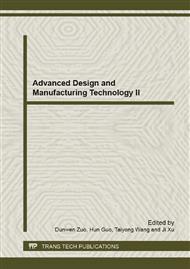p.70
p.76
p.80
p.85
p.91
p.97
p.101
p.106
p.110
Influence of Air Damping on Nanoelectro-Mechanical Switches in Low Vacuum
Abstract:
In order to treat the performance of nano-electro-mechanical (NEM) switches in low vacuum, molecular dynamics model of NEM switches is established and the influence of air damping on NEM switches is investigated. When the pressure in low vacuum is from 100Pa to 1000Pa, we get the gas molecule in low vacuum belong to free molecule flow. Tersoff-Brenner potential function is used to describe the interaction of carbon nanotube atoms. L-J potential function is adopted to state the interaction between carbon nanotube and the base ground. Results show that in low vacuum condition, when the same amplitude change of intensity of pressure, the lower intensity of pressure change will take a more clearly effect for the nano structure than the higher intensity of pressure change. Results also show when the length of carbon nanotube from 200 circles to 50 circles, the beam vibrating amplitude increased gradually. When the length is 50 circles, the vibrating amplitude reach the maximum. With the beam length keep to decrease, the vibrating amplitude becomes weak crossly.
Info:
Periodical:
Pages:
91-96
Citation:
Online since:
March 2013
Authors:
Price:
Сopyright:
© 2013 Trans Tech Publications Ltd. All Rights Reserved
Share:
Citation:


